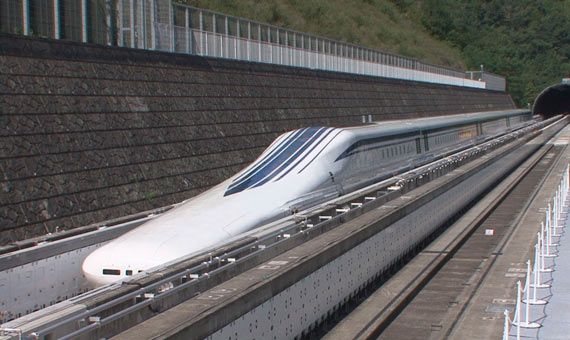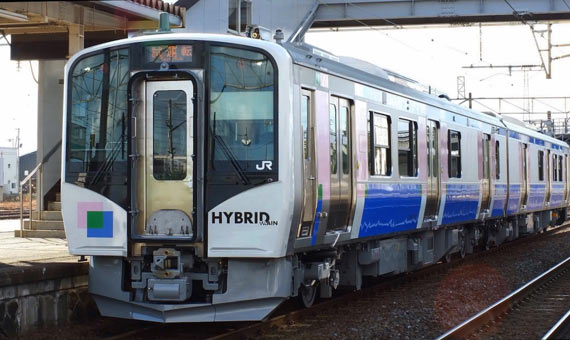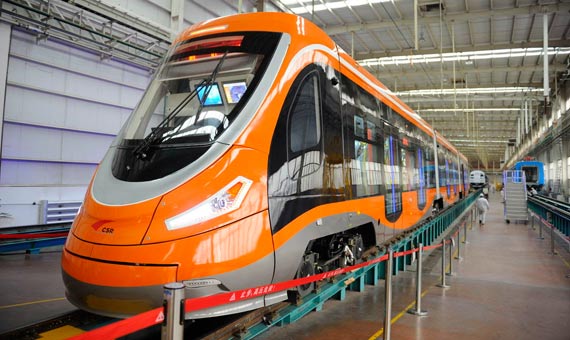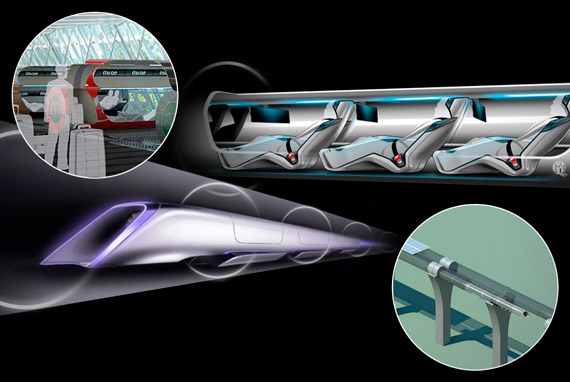603 kilometres per hour is the current speed record for railway technology, set on 21 April 2015 by the Japanese Series L0 (L zero) train, which is powered by superconductor magnetic levitation (SCMaglev). This milestone encapsulates a growing and global technological trend. In terms of speed, safety, efficiency and ecological impact, the train is picking up speed to reinvent itself in the 21st century as the most sustainable transport alternative in this time of climate emergency.
Levitation at top speed
Japan’s new bullet train will link Tokyo and Nagoya in 2027—construction delays permitting—in about 40 minutes, reaching top speeds of 500 kilometres per hour, to be extended in 2037 to Osaka with a travel time of 67 minutes. In the meantime, the prototype has already broken the world rail speed record, exceeding 600 kilometres per hour and maintaining that top speed for 11 seconds. And the key is not to touch the rails. SCMaglev technology is based on electrodynamic suspension, a physical phenomenon that occurs when a repulsive magnetic field is created between two objects, which keeps them apart.

In the case of the bullet train, this means that the carriage levitates 10 centimetres above the rails; in other words, there is no friction between the train and the tracks to slow it down. To achieve this, the chassis is fitted with a series of superconducting magnets powered by a gas generator, which create a magnetic field. The tracks on which the vehicle runs are fitted with coils which interact with the magnetic field and generate their own induction field. Because of their layout, these coils have a two-fold effect: on the one hand, they make the train levitate, and on the other they guide and stabilise its course. The train levitates at 150 kilometres per hour and runs on rubber wheels until reaching that speed.
In 2020, an improved version of the Series L0 was unveiled, which dispenses with gas turbines, as in this case the carriages are powered by the induction of electricity drawn wirelessly from the tracks. Therefore, the train does not consume any fuel or produce any emissions, and the electricity to the tracks can be supplied from renewable sources, so the environmental impact is minimal. Although maglev trains consume slightly more energy than conventional trains, their balance sheet is very favourable compared to even the most efficient aircraft.
The present is hybrid… AND THE FUTURE IS ELECTRIC?
As far as conventional trains are concerned, just under a third of the global rail network is currently electrified, some 375,000 km out of a total of 1.3 million. This means that the vast majority of the network still relies on self-propelled locomotives, and diesel fuel has so far been the standard solution. Hybrid trains are today a transitional step, but 100% electric trains are on the horizon.
In 2007, Japan introduced the first diesel-electric hybrid trains on a rural line. In 2015, the first intercity service began operating, connecting the 20 stations along the 47.2-km Senseki-Tōhoku Line at a top speed of 100 kilometres per hour. The advantage over a conventional train is that nitrogen oxide emissions are reduced by 60% and diesel consumption by around 10%.

The hybrid engines in these trains are similar to those of cars. The environmental and efficiency improvement is provided by two 15 kilowatt-hour lithium batteries per carriage. The batteries change their behaviour depending on the state of the train. When motionless, they power the train’s auxiliary systems. During start-up, and using an inductor that transforms the direct current of the batteries into alternating current, the train begins rolling with the diesel engines switched off; once the vehicle is moving, the diesel engines begin to operate. The braking of the train is used to recharge the batteries.
However, although this technology is widely used in automobiles and easy to adapt to trains, it has not yet taken off and is only found in isolated cases or in pilot projects. The medium-term future is the all-electric train, powered by batteries that avoid the need for overhead lines or electrified rails. This is actually a very old idea: the first battery-powered locomotive was manufactured in 1837, although the system did not become widespread. Much more recently, in 2014 Japan introduced battery-powered passenger trains, and the following year the UK tested an electric locomotive for commercial use for the first time in 50 years, a prototype of the IPEMU (Independently Powered Electrical Multiple Unit) project, which carried passengers as part of a plan for the British rail network to cut its costs by 20%, while also curbing harmful emissions into the atmosphere.
The drawback of electric trains is the heavy weight of the batteries and their limited range, which reduces their usefulness. This is why trains are often used that combine batteries with a roof-mounted pantograph to connect to an overhead line, allowing them to run on partially electrified sections, so that the line recharges the batteries for the non-electrified sections. Today there is interest in tri-mode trains, which combine batteries and pantograph with a diesel engine to offer greater versatility. Several countries now make use of electric trains to a greater or lesser extent.
The Green Alternative of Hydrogen
One alternative for electric trains is to generate their own energy from hydrogen, a renewable and non-polluting resource. This is the alternative proposed by hydrail technology. The two main strategies to achieve this are either to burn the hydrogen or to use it in a fuel cell.
The fundamental difference is that in the first case the hydrogen is burned in an internal combustion engine (like a petrol engine), emitting no CO2 but nitrogen oxides, which contribute to the greenhouse effect that causes climate change. In a fuel cell, hydrogen reacts chemically with oxygen and in this case the only emissions from the reaction are heat and water, so vehicles using this technology (FCEVs) are considered to be zero-emission, that is, they are non-polluting.

In the past decade, several hydrail technology projects have started to come off the drawing board and pass through the testing phase. Aruba, a Caribbean island and part of the Netherlands, introduced the first regular hydrogen tram service in 2012, followed by Dubai and other urban lines. However, the leap to large passenger trains has been slower. In 2016, France’s Alstom introduced the Coradia iLint, the first passenger train powered by hydrogen fuel cells, which began operating in Germany in 2018. Several European countries have already introduced iLint or plan to do so in the coming years, including Italy, France, Sweden, Poland, Austria, the Netherlands and the UK.
Metropolitan revolutions
The monorail has been an option studied as early as the 19th century, and envisaged during the 20th century as the futuristic vision of the urban transport system. However, they have been used primarily as a tourist attraction. Monorails for urban mass transport today operate mainly in Japan and China, but currently there are several projects underway in cities such as Cairo, Bangkok and Bahia. The São Paulo monorail, planned to be the second longest and highest capacity monorail in the world after Chongqing (China), and currently carrying 500,000 passengers a day, is partially operational, but has suffered chronic delays that have pushed the project’s completion date to 2024. 54 seven-carriage trains (model INNOVIA 300 from the manufacturer Bombardier) will travel the 27 kilometres of Metro Line 15 in fifty minutes. The trains will be fully automated, without a human driver. Monorail passengers using the new line from one end to the other will save one hour and ten minutes compared to the time it would take them to travel the same distance by car (two hours).
At a time when sustainability has become a key objective, interest in the monorail has been revived. The savings of this transport system are also reflected in the rail infrastructure. The use of new materials (borrowed from aeronautics) allows for lighter systems, making the lines much cheaper to build, and they are 10% more energy efficient than a traditional rapid transit system.
Hyperloop, a “train” pushed to the limit
Though it can hardly be called a train, the Hyperloop is the project of entrepreneur Elon Musk (co-founder of PayPal, Tesla and SpaceX), who described it as “a cross between the Concorde, a rail gun and an air hockey table” when he unveiled his proposal for a new means of transport in 2013. But the vision of the idea is best explained in figures: to traverse the 616 kilometres that separate San Francisco and Los Angeles in a mere 30 minutes. In other words, to travel at transonic speeds, those nearing supersonic speeds (the sound barrier is broken at 1,234.8 kilometres per hour).
The technological miracle would be possible by treating the train as a projectile, which would circulate through a quasi-vacuum tube. At the front of the vehicle, a gigantic fan would suck in the air to prevent the train from slowing down and causing turbulence. The near-vacuum tube would help achieve the high speeds by providing one thousandth of the atmospheric pressure at sea level. And for propulsion, the same philosophy as maglev would operate: a repulsive electromagnetic field that would eliminate friction by levitating the vehicle.

The idea of the Hyperloop was born with the ambition to change the entire world economy.
The dream was to cross the Pacific in one night to transport goods from the United States to China. Distant cities would be simplified as points on an intercontinental rapid transit line. Over time, however, expectations for this potential new mode of transport have been tempered by doubts about its technical and economic feasibility and its safety and comfort for passengers. There has been no progress on the proposed line between Los Angeles and San Francisco.
Musk conceived the project as “open source”, inviting other companies to join, and there are currently at least seven companies developing the system. One of them, Virgin Hyperloop, part of Richard Branson’s group of companies, conducted the first passenger test in Las Vegas in November 2020, albeit at a modest velocity of 172 km/h. The current Hyperloop speed record was set in July 2019 by a small prototype at the Technical University of Munich, but its 463 km/h is still well below the 574.8 km/h reached by the French TGV in 2007, the fastest mark for a conventional train on steel wheels.
The Hyperloop is now the subject of several projects around the world, some of them already frustrated, such as that of Hyperloop Transportation Technologies, which intended to build the first line in California’s Quay Valley. It is still too early to tell whether the Hyperloop will become a reality or whether it will be abandoned. Nor is the root of the project inspired by sustainability considerations; it has been argued that Musk’s idea of covering the tube with solar panels would not provide enough energy, so energy issues could also threaten to derail this dream for a futuristic transportation system.
Comments on this publication